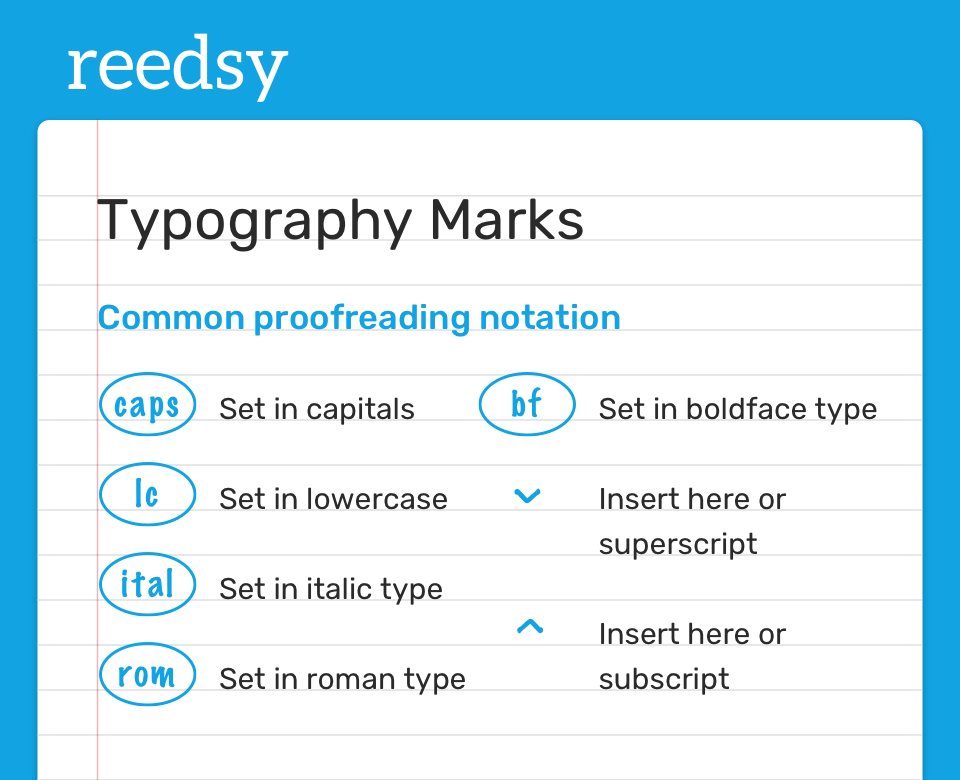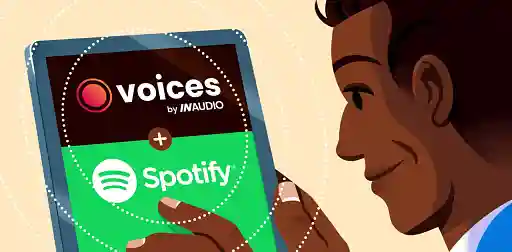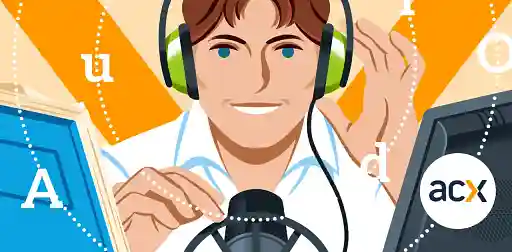Blog • Understanding Publishing
Last updated on Oct 14, 2025
What Do Proofreading Marks Mean?
Dario Villirilli
Editor-in-Chief of the Reedsy blog, Dario is a graduate of Mälardalen University. As a freelance writer, he has written for many esteemed outlets aimed at writers. A traveler at heart, he can be found roaming the world and working from his laptop.
View profile →Having your work come back from an editor covered in red pen is daunting to begin with. Receiving a manuscript that's covered in proofreading marks that might as well be hieroglyphics can be even more intimidating.
But before you reach for your cipher wheel, remember that the purpose of proofreading marks isn’t to confuse you. It’s to provide a detailed roadmap to a professional and polished final manuscript. While independent authors are not likely to spring for large print runs that would be ruined by more than a couple of typos — proofreading still remains an essential step for most serious self-publishers.
These days, it’s unlikely for the proofreading process to occur via pen-and-paper, meaning that the use of proofreading marks is also becoming increasingly rare. Most proofreaders used tools such a “tracked changes” to flag issues — and many indie authors choose to forgo professional proofers for software such as Grammarly or the simple red, dotted line that signifies a typo in processors such as Microsoft Word or Google Docs.
That being said, screen fatigue is a real thing, and there’s something about a hard-copy document that seems to draw the eye to errors more than a digital one. So if you’re working with a proofreader and want to ensure the collaboration fulfills its top potential, it’s worth getting to know the meaning of the more common proofreading marks.
So, without further ado…
What are proofreading marks?
Proofreading marks are used to highlight spelling, vocabulary, grammatical, and punctuation errors, along with formatting and layout issues.
When proofreaders are editing a hard-copy manuscript, they will leave corrections on both sides of the margins: on the left-hand margins for corrections in the first half of the sentence and on the right-hand side for corrections in the latter half of the sentence. A corresponding mark will also be included in-line to indicate where the issue is.
Alright, now let’s take a look at these formidable editing symbols.
Proofreading marks chart
The following proofreading symbols are taken from The Chicago Manual of Style 17th edition. While in-house style guides may vary from publisher to publisher, these symbols are standard across the industry.
Let’s start with operational marks, which cover everything from spelling to sentence structure to improper spacing.
 Whereas most proofreading terms are fairly straightforward (I think we can all surmise what “insert period” means), some of the operational instructions may be a little less familiar, so we’ll quickly cover the less common ones:
Whereas most proofreading terms are fairly straightforward (I think we can all surmise what “insert period” means), some of the operational instructions may be a little less familiar, so we’ll quickly cover the less common ones:
- The “delete” symbol on its own will refer to a word, while “delete and close up” will refer to a letter in a word.
- The “let it stand” symbol would be used when more than one round of proofreading was done, and it indicates that a correction or alteration should be ignored.
- The “transpose” symbol indicates the order of words needs to be changed (spot the transpose problem).
Next up are the punctuation marks, which — you guessed it — indicate that punctuation needs to be added.

Then there are typography marks, which denote formatting corrections.

Lastly, these are common abbreviations used by proofreaders to indicate issues related to the copy itself.

The importance of proofreading
Ensuring that your book is polished and error-free is just as important to the reader experience as the writing quality. Your book can’t effectively communicate if the reader is constantly paused by spelling mistakes, awkward sentence structures, or uneven spacing.
Here's what these proofreading marks look like in use, when a proofreader returns a manuscript, and when their suggestions have been incorporated:

Q: How are human proofreaders different from proofreading tools like Grammarly?
Suggested answer
The problem with relying on any piece of editing software is twofold: 1) They tend to only catch a fraction of issues in a piece of writing, and 2) In my experience, the vast majority of what they suggest is flat-out wrong or misguided. When I used to double-check things by running them through Grammarly, I’d spend most of the time sifting through suggestions that would actually add errors and clunky language to a manuscript rather than fixing them. That’s why I recommend letting an editor figure out what’s useful and what’s not, rather than having to sort through it and figure it out yourself!
These days, of course, most people asking this question are asking more about generative AI tools than “traditional” editing software like Grammarly and ProWritingAid (and indeed, those companies have also embraced dubious AI features). The most important consideration for a writer using these AI models for any purpose is the legal and ethical consideration: there is no major generative AI language model that does not involve plagiarism and theft. They were built off of the copyrighted works of hundreds of thousands of published authors and tens of millions of other writers and internet users, taken without consent or compensation. Moreover, AI-generated material cannot be copyrighted, leaving even works that mix real writing and artificially generated text on legally shaky ground.
I’ve experimented with hundreds of editing prompts on the most up-to-date models like GPT4 and Claude 3.5, as well as writing/editing-specific services like the abysmal GrammarlyGO and ProWritingAid “Sparks,” with very mixed results at best. While they can generally produce “grammatical” text on a short sample, without relation to the larger context, nuance, and style of a manuscript, the edited text is rarely what you asked for. Many times, the edits are even the opposite of what you requested, or result in new issues, and the tools cannot even accurately describe what changes they made.
Ultimately, I can see many potential uses for both writers and editors with such tools (if the major ethical and theft issues are somehow resolved), but right now they are just as likely to make things up and lead you far astray as get you closer to a solid final product, not to mention plagiarize while doing so.
At the end of the day, you’re hoping for people to read your book. Having an experienced, personal, human eye in the editing phase is essential.
Dylan is available to hire on Reedsy ⏺
Absolutely not! Proofreading tools like Grammarly are handy for quick checks, but they’re no substitute for a human proofreader or editor.
Tools like Grammarly can catch typos and basic grammar mistakes and even suggest some rewording. But at the end of the day, they’re just following rules and algorithms. They don’t understand your writing like a human does, and they may not break a rule if you want it to be broken.
A human proofreader gets the context, tone, and the subtleties in your words. They know when a sentence needs to break a rule for impact and when your unique style is intentional. Plus, humans spot the tricky stuff—like homonyms (think “your” vs. “you’re”), awkward phrasing, and shifts in voice or consistency. And let’s be honest, Grammarly might give you suggestions, but sometimes it makes things sound robotic or just… off.
Bottom line? Use the tools—they’re helpful! But for that final layer of polish, flow, and true understanding, a human touch makes all the difference.
Eilidh is available to hire on Reedsy ⏺
Regarding Grammarly and AI generally, I was recently in contact with someone doing a PhD on AI's potential affect on book editing. So naturally I asked her if AI will run me out of business.
Her response was: "I think for now AI will definitely not run you out of business. You have a wealth of knowledge and experience that can’t be trained by a data set."
The same goes for proofreading. There's no substitute for an experienced professional when it comes to complex and subjective things like proofreading and editing
John is available to hire on Reedsy ⏺
Definitely not! Grammarly is useful for certain types of copywriting. It has its benefits in terms of tightening up sentences and keeping your punctuation relatively consistent. It's great if you're used to writing in UK English but you want your manuscript to be in US English. But even the pro version misses a lot if your goal is a finished, polished manuscript to make up the inside pages of your book.
My other bugbear is that Grammarly suggestions take all the personality out of your writing! It's very easy to overuse it and end up with a piece of text that sounds like something anyone could have written. For something that's as big of a milestone as your book, it's much more rewarding to work with a human who can discuss your choices and show you how to implement them correctly, rather than a machine that irons them out because it thinks it knows best.
Mairi is available to hire on Reedsy ⏺
Looking to get your book proofread?
First, we recommend doing as much of the work yourself as possible. Here are a few resources that will help:
- Reedsy Studio will point out spelling and grammatical errors as you go.
- How to Self-Edit Your Manuscript Like a Pro is a free Reedsy Learning course covering the ten most common writing mistakes — how to find and how to fix them.
- What to Expect From Beta Readers is an informative blog post about how to work with beta readers to get your book ready for publication.
- What Are Sensitivity Readers? is all about the controversial topic of sensitivity readers and what they actually do.
Free course: How to self-edit like a pro
Rid your manuscript of the most common writing mistakes with this 10-day online course. Get started now.
Once you’ve done all the proofreading work you can, we encourage you to consider working with a professional. Proofreading is the final stage of the editing process and will ensure your book fully meets its potential for success.
The average costs of working with a professional proofreader on Reedsy are:
- $350 for a 40k-word book
- $520 for a 60k-word book
- $700 for an 80k-word book
Head to our marketplace to request quotes from a variety of professional proofreaders for free, or check out this post for more information on what you might expect to pay for professional proofreading services.
Hire an expert proofreader on Reedsy
Ed W.
Available to hire
I'm an experienced proofreader whose clients include University of Washington Press, Mountaineers Books, and The Yale Review.
Paul H.
Available to hire
I have a PhD in philosophy and two decades' experience in editing humanities manuscripts for university presses and independent authors!
Eric H.
Available to hire
AP-trained copy editor now editing and proofreading for newsletters, university-affiliated authors, and of course my fab Reedsy clients!









